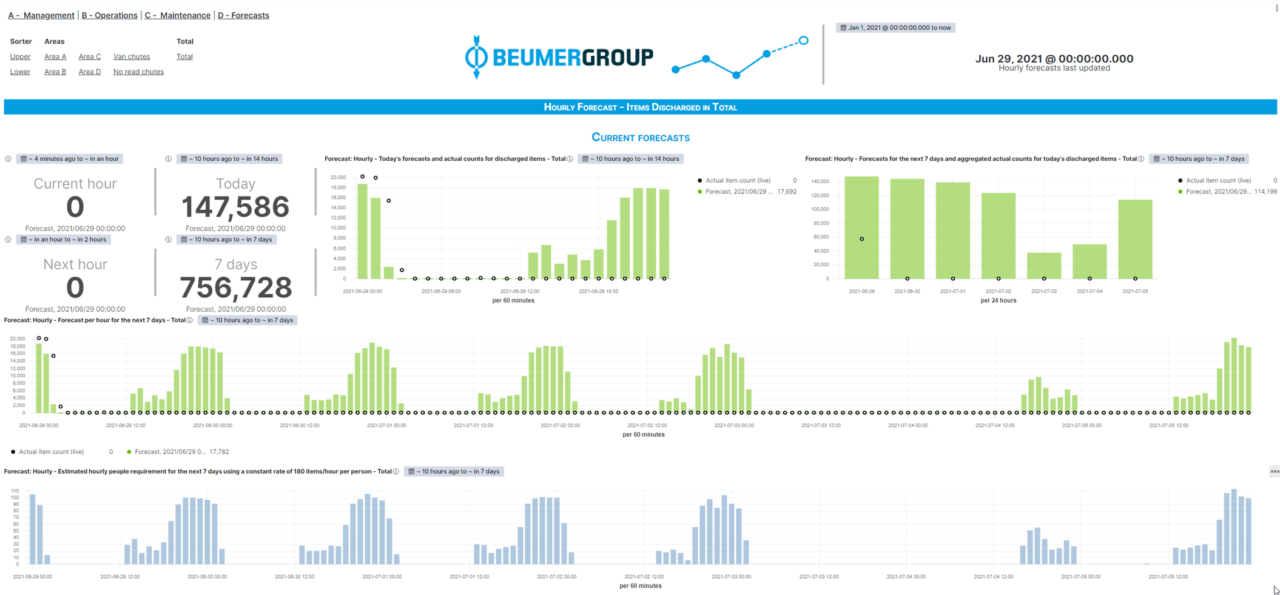Increasing parcel handling efficiency through data analytics
In the always competitive Courier, Express and Parcel (CEP) industry, companies are constantly on the lookout for that next big technological advancement.

In the always competitive Courier, Express and Parcel (CEP) industry, companies are constantly on the lookout for that next big technological advancement.
By Sebastian Titze
The industry is increasingly viewing digitisation as a viable optimisation strategy. The good news is that in today’s CEP sector, distribution centres have access to both the data and the processing power to analyse and apply that data. Combining the processing capacity of modern computers with sensors enables insights that were unimaginable only a few years ago.
Sebastian Titze, the Director of Digital Transformation from the Beumer Group was recently at a CEP industry conference in Frankfurt. He had an example of a data analytics control room to help visually answer some of the most commonly asked questions concerning data analytics within the CEP sector.
“The first question is always, can I even use data analytics with the equipment that I have?” Titze said.
“The clear answer is absolutely yes. Any equipment, no matter how old it is, has been logging a lot of data and generally, any system produces a lot of log files and data that you can use for data analytics.”
Titze breaks data analytics down into three important phases:
1. Descriptive analytics – “You can actually start with describing what happened,” he said. This has a lot of value, because once you can describe what happened, you can also start to understand why it happened.”
2. Diagnostic analytics – Titze said that this phase has a lot of value for an organisation when it comes to understanding the bottlenecks, shortcomings and bad habits within its operation.
3. Predictive analytics – The point at which distribution centres’ experience and data combine to forecast patterns that the human eye would miss and know the measures to take to eliminate a future problem predicted by the system.
Titze states that while operators frequently want to know how data can help them with the predictive phase right away, he believes that the earlier stages of data analytics provide value of their own and that all levels of analysis can have a significant impact on the through put and efficiency of a sortation system.
Different types of data demonstrate how each component of the sortation system operates.
Raw data – Different PLCs are installed in the sortation system, which makes up the physical portion of a distribution centre. These PLCs pick up a wide range of system data, including temperature, vibrations, power usage, processing speed, and a lot more.
Edge analytics – Weighing units are a crucial element in practically all sortation schemes. The processor inside weighing units functions as a miniature computer and has the capacity and ability to handle all types of information linked to the process of weighing.
Edge analytics and raw data both contribute to the performance of the sortation system, albeit to varying degrees. For instance, the weighing unit will locally analyse the data and will be able to pinpoint an issue. The conclusion will be drawn by data processing, not by the sensors.
After the data has been analysed, patterns start to emerge. Some examples of the value that data creates include:
Achieving digital maturity – Parcel distribution centres can reach a point where experience gained over time can be combined with data to reach a predictive level where they can see patterns that a human eye would never see. This is when the sortation system provider, who has experience with automated sorting and the data log files, will be able to step in and help reach the next step, which is a higher level of digital maturity.

Every distribution centre can benefit from . But in order to get started, it might be helpful to understand the different levels of digitalisation to determine where your distribution centre finds itself right now.
1. Manual operation – The pen and paper method. Rules for when the sortation system needs service are typically based on a calendar. Every piece of information is written down and stored manually. Breakdowns are handled once they occur. Repairs or optimisations generally take place when they are obviously required or when throughput drops noticeably.
2. Basic digitalisation – Sensors in automated machinery detect information from the entire sortation system. Information is stored digitally. Every part of the system is constantly monitored. Data is collected and provides a clear view of how the system performs. Data serves as an aid to understand what and why something happened. Operators are data-driven in their work as well and react when digital predetermined conditions are met.
3. Advanced digitalisation – The combination of multiple data sources reveals patterns about the system’s performance, performance in specific scenarios, and likely outcome. Algorithms allow you to optimise the system by predicting operating and equipment levels.
4. Full digitalisation – The level where you know what to do to solve a problem that the system predicts will happen in the future. On the level of equipment, this could mean knowing when and which parts to swap out. On an operational level, this means knowing what choices to make to avoid a situation where there is a bottleneck. Depending on the level of autonomy, the system can suggest an action, tell you about an action that has already been taken, or just do the action on its own.
Any distribution centre that adopts digitalisation will gain advantages over time and eventually reach a greater level of digitalisation. But to take the right steps, you might need some help from a systems provider.Do you want to know more about the potential of digitalisation for your distribution centre?
Read our e-book about digitalisation for parcel distributors.